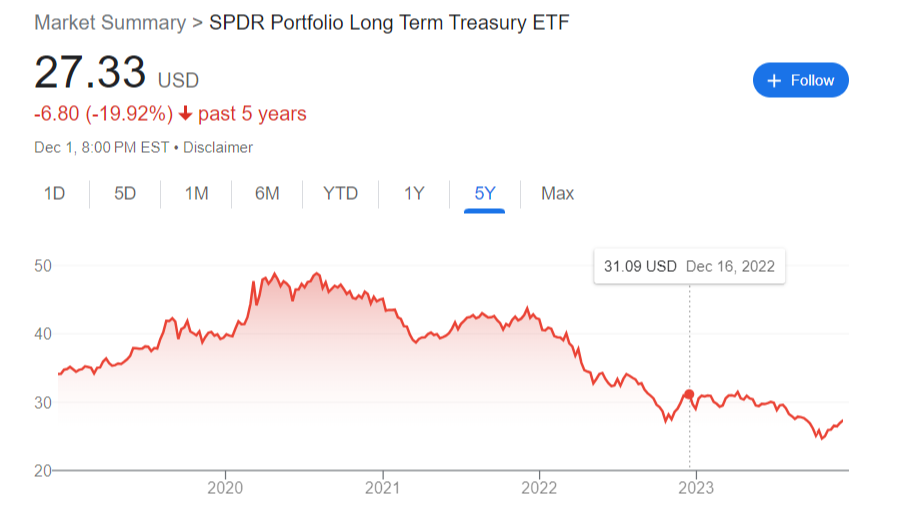Investors have a prime opportunity right now to leverage losses on long-term Treasury bonds to garner huge tax savings before the end of 2023. By harvesting tax losses on fallen Treasury investments, you could slash your tax bill on capital gains by thousands of dollars.
But you need to act quickly and strategically to take advantage of this tax-savvy maneuver without violating IRS rules. Here’s what you need to know:
Why Treasurys Have Tanked
Long-term Treasury bonds have taken a major hit in 2023, creating ripe conditions for tax-loss harvesting. The SPDR Long-Term Treasury ETF (SPTL), which tracks long-dated government bonds, has shed nearly 36% in value since its August 2019 peak.

Rising interest rates this year have particularly walloped long-term Treasury funds like SPTL. As rates climb, bond prices fall to adjust to lesser future returns amid higher yields. Thirty-year Treasury yields have nearly doubled since the start of 2022, catalyzing huge price declines.
Harvesting Losses to Slice Taxes
If you own SPTL or other battered Treasury funds in taxable accounts, selling now locks in painful losses. But those very losses can work to your advantage at tax time by offsetting capital gains from other winning investments.
Say you put $100,000 into SPTL in August 2019 and sell today for about $64,000. You’d realize a $36,000 capital loss. If you fall into the 30% tax bracket and have at least $36,000 in capital gains to offset from stocks or other assets, that $36,000 loss would reduce your tax bill by $11,000 (30% of $36,000).
Maintaining Exposure and Avoiding IRS Penalties
You may still want exposure to long-dated Treasurys despite harvesting losses for tax purposes right now. But you have to be careful about immediately buying back the same or extremely similar assets.
The IRS prohibits using a tax loss if you repurchase “substantially identical” assets within 30 days under the wash-sale rule. You can, however, pivot to alternate long-term Treasury vehicles that don’t violate this rule.
For instance, switching from the SPTL ETF to the iShares 20+ Year Treasury Bond ETF (TLT) likely clears the IRS bar. Despite both holding long-term U.S. Treasurys, they track different underlying indexes. TLT delivered similar but not identical -10.5% annualized losses since August 2019 versus SPTL’s -10.1%.
Getting Creative to Maintain Market Exposure
Tax-loss harvesting doesn’t just apply to battered bond funds. You can use the same strategy across asset classes, employing creativity to stay exposed to the market.
Say you own Bank of America stock, down 20% this year. You could harvest those equity losses and then pivot to investing in the Financial Select Sector SPDR Fund ETF (XLF) to retain financial sector exposure. XLF has moved in virtual lockstep with Bank of America over the past year, making it a sound temporary substitute.
After 30 days post-initial sale, you can then shift back into your original assets. Rinse and repeat yearly to continually harness tax losses.
Key Takeaways to Slash Your Tax Bill
Harvesting tax losses by selling battered Treasurys and other assets can unlock huge tax savings. But exercise caution:
- Mind the 30-day wash-sale rule when rebuying similar assets
- Research correlations to find suitable alternatives to temporarily pivot into
- Swap back into original assets after 30 days to maintain exposure
- Conduct analysis yearly to uncover new loss-harvesting opportunities
Acting strategically now could save you thousands on your 2023 tax tab. But consult a tax professional before executing tax-loss harvesting trades.





